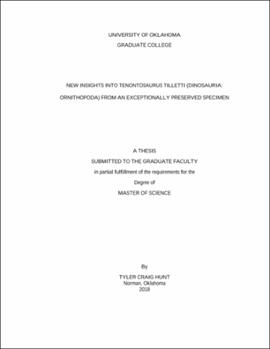| dc.description.abstract | Tenontosaurus tilletti Ostrom, 1970 is one of the most completely known Early Cretaceous (Aptian-Albian) dinosaurs, represented by more than thirty partial skeletons. Even so, some questions remain about the morphology of this species, particularly concerning the rarely preserved manual elements. Herein, I present new observations from an exceptionally well-preserved subadult specimen from the Antlers Formation of southeastern Oklahoma. Oklahoma Museum of Natural History (OMNH) specimen number 58340 preserves nearly every bone in articulation including the rarely preserved distalmost phalanges. The preservation of these manual elements reveals a phalangeal formula count of 2-3-3-2-2. With the complete hand morphology now known, only digits I and II are shown to terminate with an arched claw-like ungual, a new autapomorphy of the species. In contrast, digits III, IV, and V are terminated by small sesamoid-like phalanges, which were mistakenly interpreted as distal carpal elements. Moreover, the unique preservation of this specimen makes possible inferences about the soft tissue structure of the wrist, providing insights into the function of the carpus.
In addition to the complete manus, OMNH 58340 has five trauma and infection related skeletal pathologies. The manual phalanx I-1 and left dorsal rib 10 are fractured with signs of extensive callus formation in the later stages of healing, interpreted to be contemporaneous injuries. In addition to traumatic fractures, both elements have a morphology consistent with post-traumatic osteomyelitis. Left dorsal rib 7 and right dorsal rib 10 exhibit impacted fractures that are compressed 26 mm and 24 mm, respectively. Both lack callus formation and possess a fracture morphology consistent with pliable living bone, suggesting these fractures occurred around the time of death. Computed tomography (CT) visualizations reveal the presence of a large internal abscess in pathological metacarpal IV of OMNH 58340, with a morphology consistent with a subacute type of hematogenous osteomyelitis, termed a Brodie abscess. This is only the second report of an injury of this type in non-avian dinosaurs and the first in Ornithopoda. Based on the location and two distinct phases of healing present, I hypothesize that this individual experienced a minimum of two traumatic events (e.g., from a fall) with the injuries of the former developing chronic osseous infections. | en_US |
